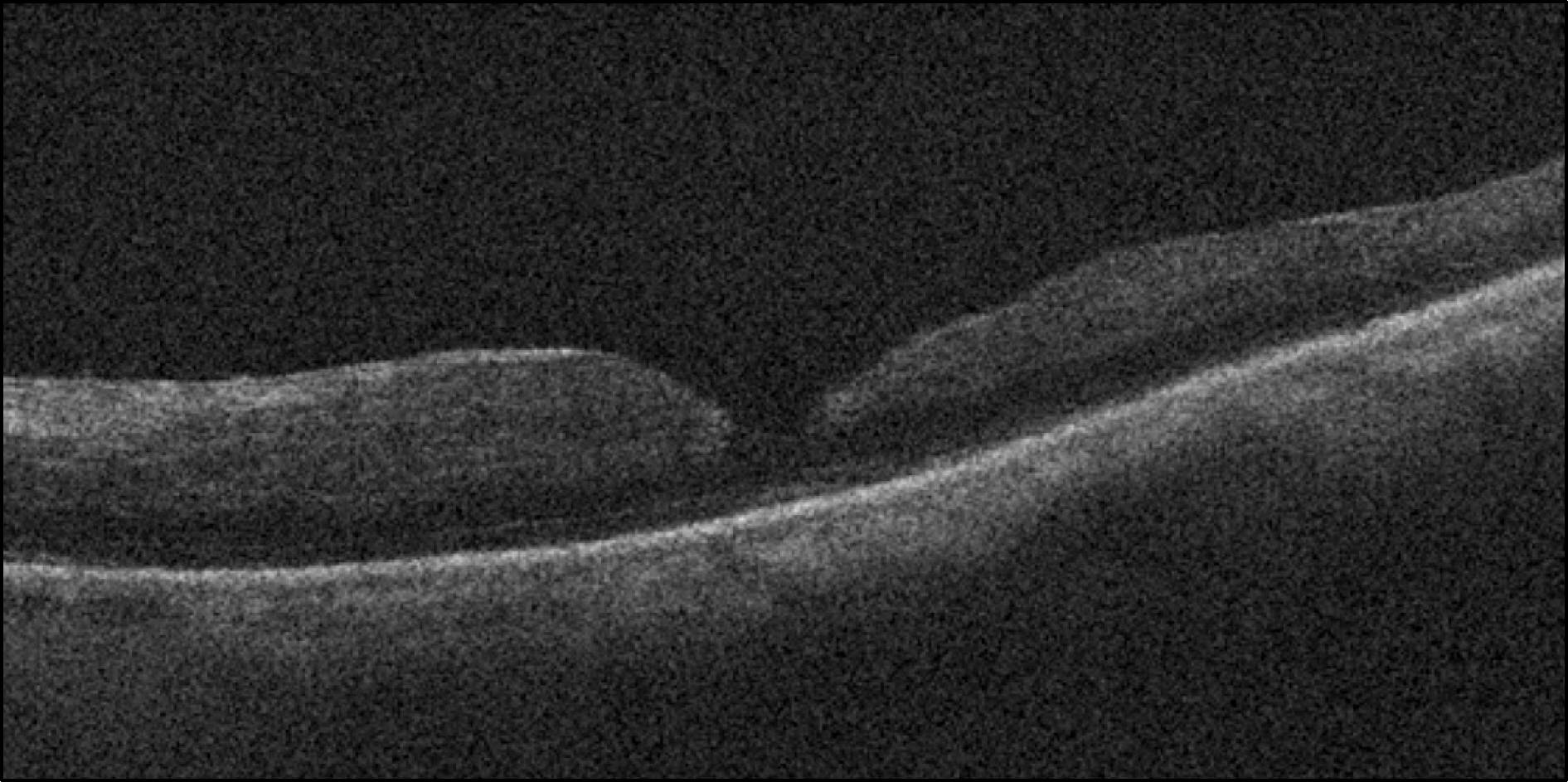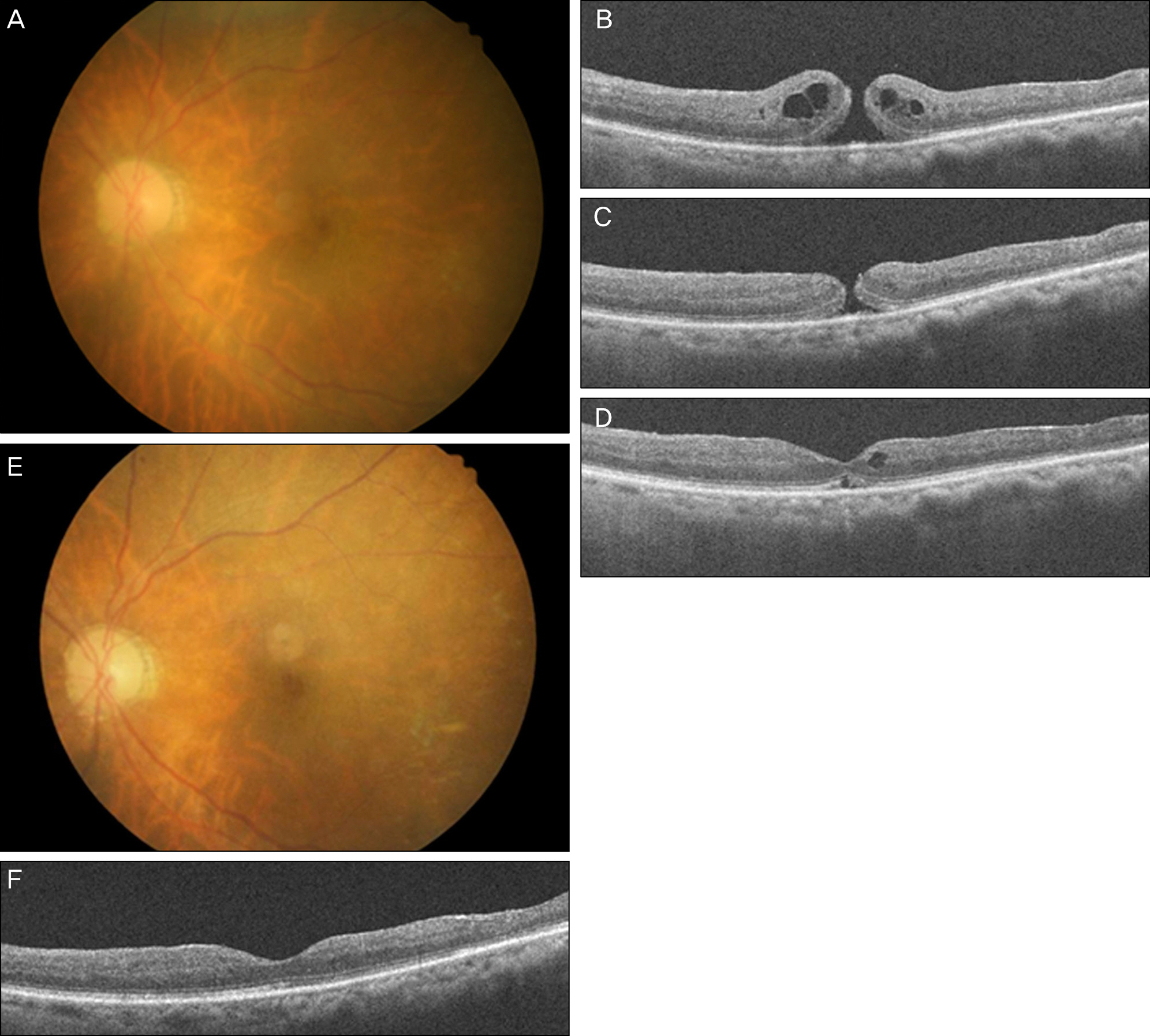J Korean Ophthalmol Soc.
2013 Oct;54(10):1626-1629.
A Case of Spontaneous Closure of Macular Hole in a Previously Vitrectomized Eye
- Affiliations
-
- 1Department of Ophthalmology, Catholic University of Daegu School of Medicine, Daegu, Korea. yykim@cu.ac.kr
Abstract
- PURPOSE
To report a case of spontaneous closure of a macular hole in a previously vitrectomized eye.
CASE SUMMARY
A 71-year-old female had undergone vitrectomy on the left eye due to a secondary epiretinal membrane with vitreous opacity caused by vasculitis. After the procedure, while the patient was still on medication for the recurrent inflammation of the anterior and posterior segment of the vitreous, a macular hole was found after fundus examinations. Visual acuity of her left eye was 0.125 and ocular coherence tomography (OCT) confirmed a full thickness macular hole with a perifoveal cyst. We recommended vitrectomy, internal limiting membrane peeling, and intravitreal gas injection, but the patient refused further intervention due to her poor general condition. After 2 weeks, resolution of the perifoveal cyst with the macular hole was observed. After 13 weeks, OCT revealed the complete closure of the macular hole with normal foveal depression and the patient regained 0.4 visual acuity.
CONCLUSIONS
Spontaneous closure of macular hole is a rare phenomenon in vitrectomized eyes, but a small macular hole with inflammation may close spontaneously without additional intervention. Therefore, observation should be considered rather than hasty surgical intervention. Apparently, the spontaneous closure of a macular hole is due to degenerative processes such as development of macular edema and natural recovery.
Keyword
MeSH Terms
Figure
Reference
-
References
1. Privat E, Tadayoni R, Gaucher D. . Residual defect in the fo- veal photoreceptor layer detected by optical coherence tomography in eyes with spontaneously closed macular holes. Am J Ophthalmol. 2007; 143:814–9.2. Yonekawa Y, Hirakata A, Inoue M, Okada AA. Spontaneous closure of a recurrent myopic macular hole previously repaired by pars plana vitrectomy. Acta Ophthalmol. 2011; 89:e536–7.
Article3. Tsilimbaris MK, Gotzaridis S, Charisis SK. . Spontaneous closure of macular holes developed after pars plana vitrectomy. Semin Ophthalmol. 2007; 22:39–42.
Article4. Lo WR, Hubbard GB. Macular hole formation, spontaneous closure, and recurrence in a previously vitrectomized eye. Am J Ophthalmol. 2006; 141:962–4.
Article5. Ogawa M, Ohji M. Spontaneous closure of a macular hole after vitrectomy for an epiretinal membrane. Jpn J Ophthalmol. 2010; 54:357–70.
Article6. Hanano R, Shimoda Y, Kishi S. Tomographic features of spontaneous closure of full-thickness macular holes. Jpn J Ophthalmol. 2007; 51:76–7.
Article7. Lipham WJ, Smiddy WE. Idiopathic macular hole following vitrectomy: implications for pathogenesis. Ophthalmic Surg Lasers. 1997; 28:633–9.
Article
- Full Text Links
- Actions
-
Cited
- CITED
-
- Close
- Share
- Similar articles
-
- A Case of Spontaneous Closure of Recurring Chronic Full Thickness Macular Hole
- A Case of Secondary Macular Hole Formation after Phacoemulsification in a Vitrectomized Eye
- The Spontaneous Resolution of Idiopathic Macular Hole Diagnosed with OCT
- Autologous Retinal Flap Transplantation of a Refractory Giant Macular Hole with Retinal Detachment
- Delayed Closure of Macular Hole with an Internal Limiting Membrane Flap After Intravitreal Triamcinolone Acetonide Injection: Case Report



